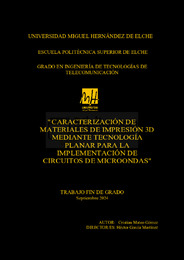Por favor, use este identificador para citar o enlazar este ítem:
https://hdl.handle.net/11000/33943Caracterización de materiales de impresión 3D mediante tecnología planar para la implementación de circuitos de microondas
| Título : Caracterización de materiales de impresión 3D mediante tecnología planar para la implementación de circuitos de microondas |
| Autor : Mateo Gómez, Cristian |
| Tutor: García Martínez, Héctor |
| Editor : Universidad Miguel Hernández de Elche |
| Departamento: Departamentos de la UMH::Ingeniería de Comunicaciones |
| Fecha de publicación: 2024-09 |
| URI : https://hdl.handle.net/11000/33943 |
| Resumen : Como propósito principal, del mismo proyecto, nos centramos en aplicaciones de impresión 3D. Esta herramienta de fabricación nos permite crear estructuras de circuitos impresos en el rango comprendido de las microondas de tecnología microstrip. Es sabido que en este tipo de líneas de transmisión se debe realizar un cálculo previo para definir características del dispositivo. En este proceso de cálculo, debemos elegir nuestro material aislante a la frecuencia y fase característica deseada, que, dependiendo de las propiedades del sustrato, obtenemos los valores involucrados de muchos factores como la distancia entre planos de la sección transversal [1], anchura o distancia de la pista, etc. Sin embargo, esa elección del material aislante involucra muchas propiedades de las que debemos ser conocedores. En este proyecto, aplicamos un método resonante para la caracterización del material dieléctrico usado como filamento en impresión 3D. La finalidad de la caracterización es conocer las propiedades dieléctricas de cada material (PLA, ABS, Preperm3), siendo las propiedades más relevantes la permitividad relativa y la tangente de pérdidas. Para realizar este método y ser capaces de modelizar estos materiales exponemos todas las partes involucradas de este desarrollo de investigación, estructurado en 5 capítulos. En el primer Capítulo, se realiza una clara introducción del Trabajo Final de Grado y explicación de los objetivos planteados. En el segundo Capítulo, se hace constancia del marco teórico en el que estamos trabajando, explicando que es la impresión 3D y sus diferentes tecnologías, la relación física que hay implicada de los dispositivos resonantes, tecnología microstrip y la resonancia a alta frecuencia, siendo este el método empleado para la caracterización. En el tercer Capítulo, se expone de manera clasificada los diferentes métodos empleados en los distintos procedimientos del desarrollo, además de las características de los materiales empleados para la impresión 3D y herramientas de trabajo utilizadas de software y medición. En el cuarto Capítulo, se refleja transparentemente la evolución del desarrollo en distintas fases a nivel de diseño, fabricación, medición, caracterización y resultados. Por último, en el quinto Capítulo se muestran todas las conclusiones y análisis de todo el desarrollo de este proyecto haciendo mención de mejoras y líneas futuras de investigación As the main purpose, of the same project, we focus on 3D printing applications. This manufacturing tool allows us to create printed circuit structures within the microwave range of microstrip technology. It is well known that in this type of transmission line, prior calculations must be carried out to define the characteristics of the device. In this calculation process, we need to choose our insulating material according to the desired frequency and phase, and depending on the properties of the substrate, we obtain values involving many factors such as the distance between planes of the cross-section [1], the width or distance of the track, etc. However, the choice of insulating material involves many properties that we must be familiar with. In this project, we apply a resonant method to characterise the dielectric material used as filament in 3D printing. The aim of the characterisation is to determine the dielectric properties of each material (PLA, ABS, Preperm3), with the most relevant properties being relative permittivity and loss tangent. To carry out this method and be able to model these materials, we present all the parts involved in this research development, structured into 5 chapters. In the first chapter, a clear introduction to the Final Degree Project is provided, along with an explanation of the objectives set out. In the second chapter, the theoretical framework in which we are working is outlined, explaining what 3D printing is and its different technologies, the physical relationship involved in resonant devices, microstrip technology, and high-frequency resonance, which is the method used for characterisation. In the third chapter, the different methods used in the various development procedures are presented in a classified manner, along with the characteristics of the materials used for 3D printing and the software and measurement tools employed. In the fourth chapter, the evolution of the development is transparently reflected through different phases, including design, manufacturing, measurement, characterisation, and results. Finally, in the fifth chapter, all the conclusions and analyses from the entire development of this project, with mention of improvements and future research directions. |
| Palabras clave/Materias: impresión 3D caracterización dieléctrica microondas 3D printing dielectric characterisation microwaves |
| Área de conocimiento : CDU: Ciencias aplicadas: Ingeniería. Tecnología |
| Tipo de documento : info:eu-repo/semantics/bachelorThesis |
| Derechos de acceso: info:eu-repo/semantics/openAccess Attribution-NonCommercial-NoDerivatives 4.0 Internacional |
| Aparece en las colecciones: TFG- Ingeniería de Tecnologías de Telecomunicación |
 La licencia se describe como: Atribución-NonComercial-NoDerivada 4.0 Internacional.
La licencia se describe como: Atribución-NonComercial-NoDerivada 4.0 Internacional.
.png)
